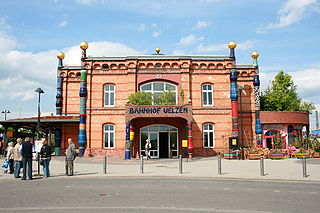The Deutscher Eisenbahn-Verein or DEV was founded in November 1964 as the Deutscher Kleinbahn-Verein. Its purpose was the preservation of a working branch line with all its installations as a living open-air museum. The term Kleinbahn was primarily a Prussian concept that referred to light branch lines with lower traffic demands and of more lightweight construction than main lines or normal branch lines, hence the Kleinbahnen were mainly found in northern Germany.
The Osthannoversche Eisenbahnen AG (OHE) is a Celle based transportation company with railway network in North-eastern Lower Saxony around the Lüneburg Heath area of over 250 km.
The Heath Railway is a regional railway line in North Germany that crosses the Lüneburg Heath from which it derives its name. Most of the line is unelectrified and single-tracked. It links Buchholz in der Nordheide with Hanover, the capital city of Lower Saxony. Together with the east-west Uelzen–Langwedel railway, this north-south line is one of the two most important railways on the heath.
The Bomlitz–Walsrode railway is a railway line in the German state of Lower Saxony that is operated by the Osthannoverschen Eisenbahn (OHE).
The Heide Express is the name used by the Lüneburg Transport Society or AVL to market special railway trips with their historic trains on the East Hanoverian Railways (OHE) railway network in northern Germany.

The Uelzen–Langwedel railway runs through the Lüneburg Heath in north Germany in an east-west direction. The line became known as part of the so-called America Line.
The Brunswick–Uelzen railway line is a largely, single-tracked, non-electrified branch line in the north German state of Lower Saxony. It serves the northern part of Brunswick Land and the eastern region of the Lüneburg Heath. The most important station en route is Gifhorn. The line has also been called the Mühlenbahn for several years due to the many mills along its route.

Uelzen is a railway station located in Uelzen, Germany, at the eastern edge of the Lüneburg Heath Nature Park. The station is located on the Hannover–Hamburg railway, Uelzen–Langwedel railway, Stendal–Uelzen railway and Brunswick–Uelzen railway. The train services are operated by Deutsche Bahn, Metronom and Erixx.
The Verden–Walsrode Railway or VWE is a transport company with its headquarters in Verden on the River Aller in North Germany.
The Aller Valley Railway was a railway line of regional importance in Lower Saxony. It ran along the River Aller and linked Gifhorn with Verden (Aller) via Celle, Schwarmstedt, Rethem (Aller) and Wahnebergen.
The Soltau–Neuenkirchen railway was a standard gauge line built for the East Hanoverian Railways in North Germany.
The Soltau–Neuenkirchen Light Railway Company opened the Soltau–Neuenkirchen railway in North Germany on 15 May 1920.
The Lüneburg–Soltau railway is a standard gauge railway line in North Germany operated by the East Hanoverian Railways.

Soltau (Han) station is in the town of Soltau in the German state of Lower Saxony, located in the centre of the Lüneburg Heath. As a junction station on two railway lines, Hannover Hbf – Buchholz (Heath Railway) and Bremen Hbf – Uelzen (Uelzen–Langwedel railway), it is a central transport hub of the region and serves commuters and visitors to the Lüneburg Heath as a destination and transfer station.
The standard gauge Beckedorf–Munster railway in north Germany is owned by the East Hanoverian Railways.
The Celle-Soltau, Celle-Munster Light Railway was until 1908 a publicly owned company run by the district of Celle in North Germany and was originally named the Garßen–Bergen Light Railway.
The Celle–Wittingen Light Railway was founded on 21 June 1902 by the Prussian state, the town of Celle and 33 municipalities. On 15 August 1904 it opened the 51 km long, standard gauge line from Celle Stadt (Nord) via Beedenbostel and Hankensbüttel to Wittingen West. This line was also called the Lachte Valley Railway (Lachtetalbahn) because part of it ran along the river Lachte. The journey time on the Celle–Wittingen line in 1906 was about 2 hours and 20 minutes. In 1908 the station at Wittingen West was moved to the east side of the state station in order to enable a common station to be created with the Kleinbahn Wittingen-Oebisfelde, opened in 1909, and the Kleinbahn Bismark-Gardelegen-Wittingen, later the Altmärkische Kleinbahn AG. The new route made the construction of embankments and a bridge over the state railway necessary.
The Wittingen-Oebisfelde Light Railway was a railway company in Germany that operated passenger and goods trains on the 43 kilometre long Wittingen–Oebisfelde railway.

Beckedorf is a village in the municipality of Südheide in northern Celle district in the German state of Lower Saxony. Situated on the western edge of the Southern Heath Nature Park in the Lüneburg Heath, about 1 km southwest of Hermannsburg itself, it currently has about 610 inhabitants. The name means "village on the Beke". In old records it can be found as Beketorpe,Bekendorpe or Beckedorp. In 1973 Beckedorf was incorporated into the parish of Hermannsburg as part of Lower Saxony's territorial and administrative reforms.









